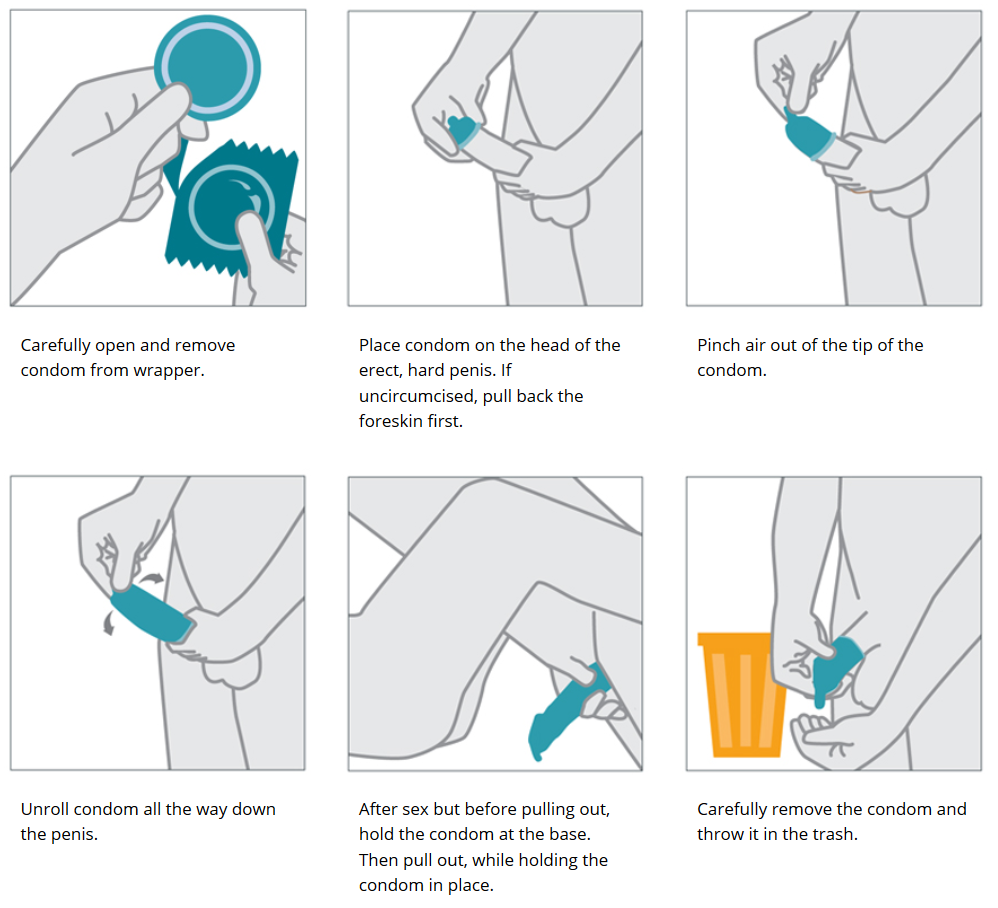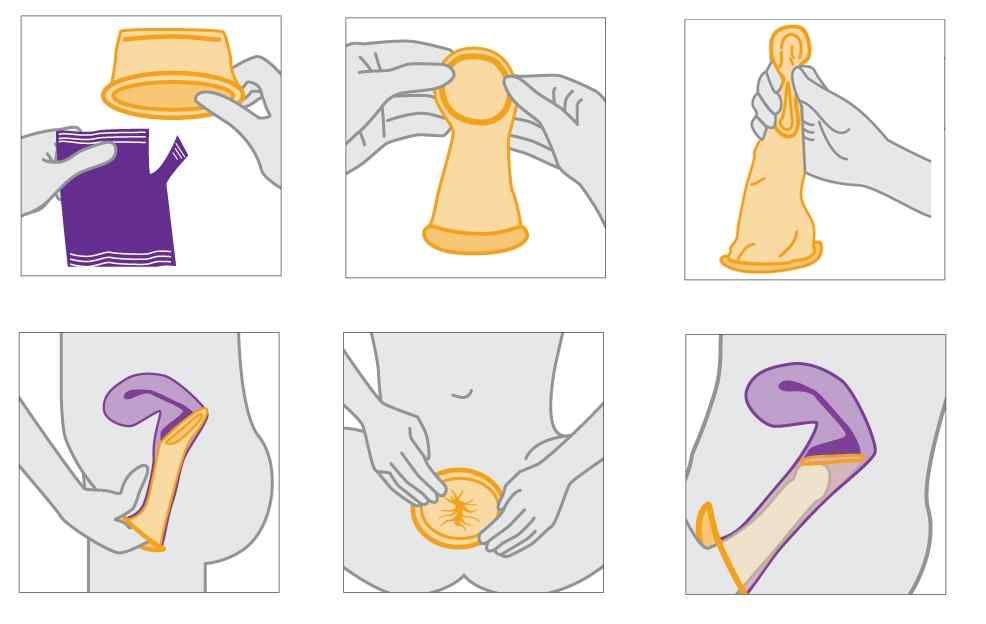Condom Connection
Condom Connection for MSU Students
During this time of COVID-19, we understand that it is important to continue to meet the sexual health needs of MSU students,During this time of COVID-19, we understand that it is important to continue to meet the sexual health needs of MSU students. Condoms are the only birth control that reduces your risk of both pregnancy and STDs, including HIV when used correctly and consistently.
-
Condom Directions
Condoms
Condoms are a barrier device made of latex or polyisoprene. They are placed over the penis during sexual activity, preventing the transmission of fluids from one partner to another. Condoms are used to prevent pregnancy and STI transmission and can be up to 98% effective.
- External Condoms (also known as male condoms) are made of both latex and non-latex

- Internal Condoms (also known as female condoms) are typically non-latex

While condoms protect against MOST STIs, they do not always protect against transmission of herpes or genital warts (Human papillomavirus or HPV) but can reduce the risk of transmission.
All condoms (internal and external) are Type II Medical devices and are held to the same safety standards as artificial heart valves and IV tubing. The Food and Drug Administration's (FDA) responsibility is to ensure every condom brand is manufactured properly and follow quality system regulations to ensure that their products do what they are intended to do: protect against pregnancy and STIs.
- External Condoms (also known as male condoms) are made of both latex and non-latex
-
Deciding Brand of Condom
Deciding Brand of Condoms
While male condoms are a great option for reducing STI transmission and pregnancy prevention, it can be overwhelming to sort through all of the brands and options available. Here is some helpful information:
- In the United States, all latex and synthetic condoms must conform to standards established by the FDA. This means that every condom is checked for defects before it is packaged. In addition, the FDA checks samples from each batch by performing airburst and water-leak tests. In the end, no matter what brand or type of condom you decide on, you can be confident the condoms will be effective if you use them consistently and correctly.
- Most condoms are made of latex, which is a natural substance tapped from rubber trees. This option has the widest selection of brands and types, it is the least expensive, and it is the most well-researched and regulated type of condom. Latex condoms can only be used with water or silicone based lubricants (no oil, lotion, or petroleum jelly). Some people are allergic to latex and can consider using polyurethane or polyisoprene condoms instead.
- Polyisoprene condoms are made from a synthetic material similar to plastic, and polyisoprene male and female condoms are recommended for people who are allergic or sensitive to latex. Clear and color, not as elastic as latex, and slightly wider than the average sized condom, they may be used with water or silicone lubricants. The material also conducts heat well and may create more sensation during sex. Research shows that polyisoprene condoms are as effective in pregnancy and STI prevention. Internal or Female Condoms are non-latex polyisoprene.
- Lambskin condoms are made of internal lamb membranes and are the oldest type of condom. These condoms are NOT effective in preventing STIs or HIV transmission. These condoms tend to be quite expensive and do not offer protection against infections.
- Some condoms come without lubrication. They are most useful for oral sex or for people who may have sensitivities to lubricants.
- Lubricated condoms contain a water or silicone based lubricant that can minimize friction and reduce condom breakage. You can apply a couple drops of additional lubrication to the inside of the condom before it is rolled on to the penis, and then a few more drops to the outside of the condom.
- Spermicidal lubricant (non-oxynol-9 or N-9) was originally thought to reduce sperm mobility and thus prevent pregnancy. However, research has found that N-9 can cause irritation and small sores in some people, and therefore may actually facilitate HIV transmission.
- Most condoms manufactured are one-size-fits all. The tightness may vary slightly from brand to brand, so try a few brands to see what you and your partner prefer. A snug yet comfortable fit decreases the chances that a condom will slip off during intercourse.
-
Increasing the Effectiveness of Condoms
Increasing the Effectiveness of Condoms
Condoms are most effective when used correctly and consistently! When having vaginal or anal sex, you should always protect yourself by wearing a condom. Sixty-nine percent of MSU students used a condom the last time they had vaginal intercourse. Properly wearing a condom every time you have vaginal or anal sex reduces your chances of contracting an STI or becoming pregnant. Condoms are the most effective non-prescription birth control method to reduce both of these risk factors.
How to Properly Use External/Male Condoms
The following steps explain how to properly put on and take off a condom. There can be many misunderstandings about the proper way to use condoms. Understand the benefits of protecting yourself and use the knowledge to your advantage!Step One: Check the date on the back of the condom wrapper to make sure it isn't expired. Carefully inspect the package for any damage. Gently tear open the package without using your teeth.
Step Two: Pinch the reservoir tip and place over the erect penis.
Step Three: With your other hand, unroll the condom down the length of the shaft, making sure there are no air bubbles.
Step Four: Have sex!
Step Five: Always remove the condom while the penis is still erect. Withdraw the penis, turn away from your partner, and gently roll it off the penis. Once removed, dispose of it in the trash, and NEVER use a condom more than once.
Quick Condom & Lubrication Tips
When using condoms...
- Do so all the time
- Don't be afraid to make putting on a condom fun
- Throw used condoms away, not down the toilet
- Use only water or silicone-based lubricants
- Don't use oil-based products (i.e. lotions, baby oil, Vaseline) as a lubricant; it breaks down the condom
- Keep firm in your stance on using condoms
- Communicate with your partner
- Contact Health Education with any questions or concerns regarding your sexual health!
Oil-based vs. Water & Silicone-based Lubrication
Negotiation Tips
There are many reasons why people try to negotiate the use and it doesn’t matter the reasons, because you and your partner’s health is more important than any excuse.
Common Excuses & Answers:- Don’t you trust me? Trust isn’t the point; people can have infections without knowing it.
- It does not feel as good with a condom. I’ll feel more relaxed. If I am more relaxed, I can make it feel better for you. We could also try a dab of water-based/silicone lube on the inside of the condom.
- I’m afraid to ask them about using a condom. Better to be protected from infection or pregnancy than scared to bring it up.
- I’m on the pill, you don’t need a condom. I’d like to use it anyway. It will help to protect us from infections we may not know we have.
- Putting it on interrupts everything. Not if I help put it on.
- I will pull out in time. Women can get pregnant and get STIs from pre-ejaculate.
- Just this once! Once is all it takes.
Common negotiation scenario excuses and sample responses:
1. "I'm afraid to ask my partner to use a condom."
Reply: Don't be afraid; it's better to have that conversation than to risk pregnancy or an STI.
2. "It doesn't feel as good when we use a condom."
Reply: I hear if you put a drop or two of lube on the tip of the penis before you put the condom on, it increases the sensation. Or, we could try out different types of condoms.
3. "I'm on the pill, you don't need a condom."
Reply: Yeah, but the pill doesn't prevent the spread of infection and it will protect us from any infections that we may not know we have.
4. "Don't you trust me?"
Reply: Of course I trust you but I would feel more comfortable if we used them. If I'm more comfortable, you'll be more comfortable.
-
Condom & Lubrication Tips
Quick Condom & Lubrication Tips
When using condoms...
- Do so all the time
- Don't be afraid to make putting on a condom fun
- Throw used condoms away, not down the toilet
- Use only water or silicone-based lubricants
- Don't use oil-based products (i.e. lotions, baby oil, Vaseline) as a lubricant; it breaks down the condom
- Keep firm in your stance on using condoms
- Communicate with your partner
- Contact Health Education with any questions or concerns regarding your sexual health!
-
Negotiating Condom Use
Negotiation Tips
There are many reasons why people try to negotiate the use and it doesn’t matter the reasons, because you and your partner’s health is more important than any excuse.
Common Excuses & Answers:- Don’t you trust me? Trust isn’t the point; people can have infections without knowing it.
- It does not feel as good with a condom. I’ll feel more relaxed. If I am more relaxed, I can make it feel better for you. We could also try a dab of water-based/silicone lube on the inside of the condom.
- I’m afraid to ask them about using a condom. Better to be protected from infection or pregnancy than scared to bring it up.
- I’m on the pill, you don’t need a condom. I’d like to use it anyway. It will help to protect us from infections we may not know we have.
- Putting it on interrupts everything. Not if I help put it on.
- I will pull out in time. Women can get pregnant and get STIs from pre-ejaculate.
- Just this once! Once is all it takes.
Common negotiation scenario excuses and sample responses:
1. "I'm afraid to ask my partner to use a condom."
Reply: Don't be afraid; it's better to have that conversation than to risk pregnancy or an STI.
2. "It doesn't feel as good when we use a condom."
Reply: I hear if you put a drop or two of lube on the tip of the penis before you put the condom on, it increases the sensation. Or, we could try out different types of condoms.
3. "I'm on the pill, you don't need a condom."
Reply: Yeah, but the pill doesn't prevent the spread of infection and it will protect us from any infections that we may not know we have.
4. "Don't you trust me?"
Reply: Of course I trust you but I would feel more comfortable if we used them. If I'm more comfortable, you'll be more comfortable.

